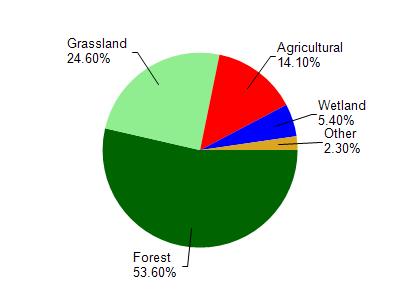Iowa
No
No
No
Fish and Aquatic Life
Overview
Morrey Creek is a warm water seepage stream. It has a Class II brown trout sport fishery in the upper 4 miles. A rare aquatic species has been found in the creek. The stream has been affected by a floodwater retarding structure built to decrease the severity of flooding and bank erosion. The creek receives discharge from the wastewater treatment plant. A stream classification survey was conducted in 1993. At the time of the survey, the stream was shaded by woody vegetation with a low density of stabilizing grasses on the banks. Streambanks were frequently eroded. Overall, the stream had good habitat and water quality for warm water fish.
Date 2002
Author Cynthia Koperski
Historical Description
Morrey Creek - Mouth location T8N R3E Section 8 -13, Surface area = 7.7 acres, Length = 6.3 miles, Gradient = 25.6 feet per mile, Total alkalinity 226.0 mg/l, Volume of flow = 2.3 cfs.
Although it has some springs feeding it, Morrey Creek is classified as a warmwater seepage stream which begins in a coulee of the Niagara escarpment in the northeastern corner of the county. It has a lower-than-average gradient and flows northerly as the principal tributary of Marsh Creek. Almost 70 percent of its watershed is cleared for farming which causes severe flooding and subsequent erosion of its banks; especially in the lower sections. Presently, a floodwater retarding structure is planned as part of the Otter Creek Watershed Plan proposed by state and federal agencles under Public Law 566. Its sport fishery consists of brown trout which are stocked by the Department of Natural Resources on an annual basis. Forage fishes present include white suckers, creek chubs, and blacknose dace. Game assets include muskrats near its mouth. There are no public lands on this stream but it is accessible from six road crossings.
From: Piening, Ronald and Threinen, C.W., 1968. Lake and Stream Classification Project. Surface Water Resources of Iowa County. Wisconsin Department of Natural Resources, Madison, WI
Date 1968
Author Surface Water Inventory Of Wisconsin
General Condition
Morrey Creek (WBIC 1220000) from Highway 133 to the headwaters was assessed during the 2018 listing cycle; new biological (fish Index of Biotic Integrity (IBI) scores) sample data were clearly below 2018 WisCALM listing thresholds for the Fish and Aquatic Life use. This water is meeting this designated use and is not considered impaired.
Date 2017
Author Ashley Beranek
Condition
Wisconsin has over 84,000 miles of streams, 15,000 lakes and milllions of acres of wetlands. Assessing the condition of this vast amount of water is challenging. The state's water monitoring program uses a media-based, cross-program approach to analyze water condition. An updated monitoring strategy (2015-2020) is now available. Compliance with Clean Water Act fishable, swimmable standards are located in the Executive Summary of Water Condition in 2018. See also the 'monitoring and projects' tab.
Reports
Management Goals
Wisconsin's Water Quality Standards provide qualitative and quantitative goals for waters that are protective of Fishable, Swimmable conditions [Learn more]. Waters that do not meet water quality standards are considered impaired and restoration actions are planned and carried out until the water is once again fishable and swimmable
Management goals can include creation or implementation of a Total Maximum Daily Load analysis, a Nine Key Element Plan, or other restoration work, education and outreach and more. If specific recommendations exist for this water, they will be displayed below online.
Monitoring
Monitoring the condition of a river, stream, or lake includes gathering physical, chemical, biological, and habitat data. Comprehensive studies often gather all these parameters in great detail, while lighter assessment events will involve sampling physical, chemical and biological data such as macroinvertebrates. Aquatic macroinvertebrates and fish communities integrate watershed or catchment condition, providing great insight into overall ecosystem health. Chemical and habitat parameters tell researchers more about human induced problems including contaminated runoff, point source dischargers, or habitat issues that foster or limit the potential of aquatic communities to thrive in a given area. Wisconsin's Water Monitoring Strategy was recenty updated.
Grants and Management Projects
Monitoring Projects
| WBIC | Official Waterbody Name | Station ID | Station Name | Earliest Fieldwork Date | Latest Fieldwork Date | View Station | View Data |
|---|
| 1220000 | Morrey Creek | 253192 | Morrey Creek - Hwy 133 | 6/1/2011 | 10/9/2019 | Map | Data |
|

Watershed Characteristics
Morrey Creek is located in the Otter and Morrey Creeks watershed which is 198.69 mi². Land use in the watershed is primarily forest (53.60%), grassland (24.60%) and a mix of agricultural (14.10%) and other uses (7.70%). This watershed has 437.57 stream miles, 351.55 lake acres and 5,785.74 wetland acres.
Nonpoint Source Characteristics
This watershed is ranked Not Ranked for runoff impacts on streams, Low for runoff impacts on lakes and High for runoff impacts on groundwater and therefore has an overall rank of High. This value can be used in ranking the watershed or individual waterbodies for grant funding under state and county programs.However, all waters are affected by diffuse pollutant sources regardless of initial water quality. Applications for specific runoff projects under state or county grant programs may be pursued. For more information, go to surface water program grants.